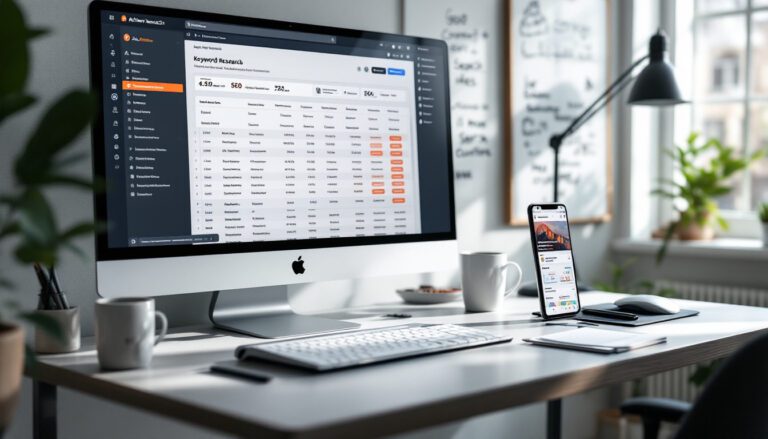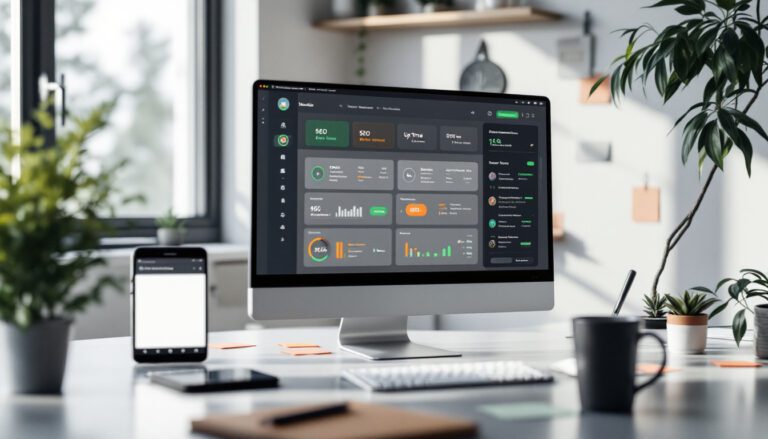How To Get Free Backlinks With No Link Building

Earning backlinks without outreach is possible through creating exceptional content that naturally attracts citations.
Focus on publishing original research, developing extensive topic clusters, and creating valuable tools like calculators or templates that others want to reference.
Engage in online communities by answering questions on platforms like Quora, participate in podcasts, and maintain updated About pages with your expertise.
Make linking easy by offering pre-written HTML snippets and custom short URLs. The strategies below will transform your passive link earning approach.
Highlights
Hide- Create exceptional content that naturally attracts citations as users reference your valuable information.
- Publish original research, statistics, and data that others in your industry will want to cite.
- Develop comprehensive topic clusters with pillar pages that become go-to resources for specific subjects.
- Participate actively in online communities by answering questions on platforms like Quora and Stack Overflow.
- Create useful tools, calculators, templates, or visual assets that others naturally want to reference.
What Getting Backlinks Without Outreach Really Means
Search engines still value backlinks as an essential ranking factor, whether they’re manually built or naturally earned.
Link building requires active outreach to website owners, while link earning happens organically when quality content attracts citations without direct solicitation.
Understanding this distinction helps website owners develop extensive strategies that leverage both approaches, creating content worth linking to while supplementing with strategic outreach when necessary.
Why Links Still Matter Even Without Manual Effort
Search engines continue to value naturally earned links and mentions as signals of content quality, even when you’re not actively pursuing outreach campaigns.
These passive forms of link acquisition, including brand citations and organic mentions across the web, contribute considerably to your site’s authority profile without requiring manual link-building efforts.
Understanding how these natural backlinks develop allows you to create content strategies that naturally attract links rather than constantly chasing after them through time-consuming outreach methods.
How Search Engines Treat Natural and Earned Links
While major algorithms evolve constantly, one principle remains steadfast in the world of SEO: search engines inherently value naturally earned backlinks more than those artificially created through manual outreach.
| Algorithm Factor | Natural Links | Manipulated Links |
|---|---|---|
| Trust Score | High | Low |
| Penalty Risk | Minimal | Significant |
| Long-term Value | Sustainable | Diminishing |
| Relevance Weight | Context-driven | Often mismatched |
| Quality Backlinks Free | Algorithmically rewarded | Frequently flagged |
The Role of Citations, Mentions, and Passive Link Acquisition
The strategic pursuit of natural backlinks extends beyond manual outreach into the domain of passive link acquisition.
Citations and brand mentions function as powerful signals to search engines, often converting to free backlinks without active solicitation.
Quality content naturally attracts how to get backlink opportunities, while industry participation frequently yields backlinks free through references.
Finding backlinks becomes organic when websites naturally reference your valuable resources.
Difference Between Link Building and Link Earning
Link building and link earning represent two fundamentally different approaches to acquiring backlinks for your website.
Traditional link building requires direct outreach where you contact website owners and request links.
On the other hand, link earning happens organically when your content is valuable enough that others reference it without being asked.
Understanding this distinction is essential because it helps you create the type of content that naturally attracts attention and links.
This is ultimately how you get “free” backlinks without manual outreach efforts.
One Requires Outreach, the Other Attracts Attention
Understanding the fundamental difference between link building and link earning can transform your entire backlink strategy.
Link building requires active outreach to get backlinks free, while link earning attracts high authority backlinks naturally through valuable content that others want to reference.
- Creating exceptional resources that authority sites want to link to
- Developing shareable content that earns edu backlinks without asking
- Focusing on value creation instead of manual outreach for backlinks to my site
Understanding How Passive Linking Happens
When website owners create content so remarkable that others naturally reference it without being asked, passive link acquisition happens organically.
This is how to get backlinks for free without active outreach.
The key distinction between building and earning links lies in the approach—one pushes, the other pulls attention naturally.
| Strategy | How It Works | Value |
|---|---|---|
| Resource Creation | Create tools others reference | High |
| Data Publishing | Share unique research | Very High |
| Expert Guides | Thorough solutions | Medium |
| Visual Assets | Shareable infographics | High |
Create Content That Naturally Attracts Backlinks
Creating content that naturally attracts backlinks requires strategic thinking about what others find valuable enough to reference.
Publishing original research, data, or studies gives other content creators something substantial to cite, while creating eye-catching visuals makes your content more shareable and reference-worthy.
Building thorough topic clusters that answer related questions guarantees your content becomes a go-to resource that others naturally link to when covering similar subjects.
Publish Research, Data, or Original Studies
Publishing research and data in your industry is one of the most powerful ways to attract natural backlinks from authoritative websites.
To compile statistics that bloggers and journalists actually want to reference, focus on gathering unique insights through surveys, analyzing existing data in new ways, or conducting original experiments that haven’t been done before.
These resources should be presented in easily digestible formats like interactive charts, infographics, or downloadable PDFs with clear citations, making it simple for others to link to your work when they need to support their own content with credible sources.
How to Compile Useful Stats in Your Niche
Many website owners overlook the powerful link-building potential of original statistics and research in their niche.
Compiling industry data creates valuable resources that naturally attract free SEO backlinks. To make backlinks through statistics, analyze existing research gaps where blog backlinks could be generated.
- Survey industry professionals and create shareable infographics to add backlinks to my website free
- Analyze trending topics using free backlink provider tools like Google Trends
- Update statistics annually to maintain relevance and continue to attract quality links
Formats That Bloggers and Journalists Prefer to Link
While traditional blog content can generate some backlinks, journalists and content creators specifically seek certain high-value formats when deciding what sources to reference and link to.
Original research reports, data visualizations, industry surveys, and extensive guides consistently earn the most blog backlinks.
Case studies with real metrics, expert roundups, and definitive resource lists also rank among the best free backlinks sources that professional writers regularly cite.
Use Visuals That Are Easy to Reference
Creating visual assets like charts, infographics, and data maps can dramatically increase your backlink potential as other websites naturally want to reference your visual content.
To make sharing even easier, include simple embed codes alongside your visuals that allow others to add your graphics to their sites with proper attribution links built in.
These shareable visuals not only improve your content’s engagement metrics but also function as backlink magnets when industry peers need to illustrate concepts that your graphics explain particularly well.
Charts, Infographics, and Data Maps That Invite Embeds
Visual assets like charts, infographics, and data maps are powerful link magnets in the digital marketing landscape.
When you create data-driven visuals that simplify complex information, other sites naturally want to reference them.
- Include embed codes beneath visuals to encourage sharing
- Create original research visualizations that can’t be found elsewhere
- Design industry-specific data maps that showcase geographic trends
Adding Simple Embed Codes for Easy Sharing
Embed codes transform your visual content into shareable assets that webmasters can effortlessly add to their sites with a simple copy-paste action.
Consider adding a small HTML snippet beneath infographics or data visualizations with pre-formatted code that includes proper attribution and a link back to your site.
This innovative approach removes barriers to sharing while ensuring you receive credit and valuable backlinks whenever your visuals are featured elsewhere.
Build Topic Clusters That Answer Follow-Up Questions
Topic clusters transform your website’s structure by creating a core pillar page surrounded by supporting content pieces that address related questions.
When you build a thorough resource hub around a central topic, each article works together to establish your authority while naturally generating backlinks from other sites seeking definitive information.
These clusters satisfy search intent more effectively than isolated articles, making them link magnets over time without requiring constant outreach efforts.
Creating a Core Page With Internal Supporting Articles
Strategically building a core page surrounded by supporting articles creates a powerful SEO ecosystem that naturally attracts backlinks.
This structure establishes topical authority while creating multiple entry points for organic traffic and link opportunities.
- Use your core page to thoroughly cover the main topic with 2,000+ words.
- Create 5-7 supporting articles that expand on subtopics mentioned in the core content.
- Interlink all pieces with descriptive anchor text that helps search engines understand relevance.
Why These Pages Earn Links Over Time Without Outreach
Well-crafted topic clusters naturally attract backlinks without aggressive outreach because they solve multiple user problems in one cohesive ecosystem.
When searchers find extensive answers to their primary and secondary questions, they view your site as an authority worth referencing.
Industry blogs, researchers, and content creators naturally link to the most thorough resources, especially when they address questions competitors haven’t covered yet.
Get Featured Without Asking for a Link
Earning backlinks without direct outreach requires strategic visibility in industry spaces where others naturally reference valuable content.
Getting featured in expert roundups and resource pages often happens when your content provides unique insights or solutions that editors naturally want to include, even without a formal link request.
Crafting attention-grabbing titles that address pressing industry questions or challenges can greatly increase your chances of being quoted, referenced, or featured by content curators who are constantly searching for authoritative sources to strengthen their own work.
Appear in Roundups and Resource Pages
Content creators can considerably increase their chances of being featured in roundups without direct outreach by strategically formatting their work.
By studying existing resource lists in your niche, you can identify common patterns and criteria that curators look for when selecting content to include.
Structuring your articles with clear headings, actionable takeaways, and unique data points makes them naturally attractive to publishers who compile industry roundups!
How to Increase Your Chances Without Outreach
While many SEO experts focus on direct outreach, getting featured in roundups and resource pages often happens organically when you create exceptional, link-worthy material.
- Develop groundbreaking research or data studies that naturally attract citations from industry publishers.
- Create visually compelling infographics or tools that solve specific problems for your target audience.
- Cultivate relationships with industry influencers by engaging meaningfully with their content before expecting links.
Formatting Your Content to Fit Existing List Criteria
Beyond creating quality content, strategic formatting can dramatically increase your chances of appearing in roundups and resource pages.
Study popular resource lists in your niche and mirror their format—whether that’s step-by-step guides, numbered lists, or comparison tables.
Include clear headings, concise summaries, and visual elements that make your content easy to reference. Match your statistics, examples, and depth to existing featured resources.
Write Titles That Editors Can’t Ignore
Headlines strategically crafted with phrases like “research shows,” “study reveals,” or “industry experts confirm” naturally attract citations from content creators seeking authoritative sources.
Editors actively search for content containing these trigger phrases when looking to support their own articles with credible references.
Headlines Built for Citations, Quotes, or Industry Mentions
Although many content creators focus exclusively on direct outreach for backlinks, crafting headlines strategically can attract citations naturally without a single pitch email.
Headlines that incorporate industry data, controversial viewpoints, or emerging trends naturally draw attention from editors seeking credible sources to reference.
- Use “[Year] + Industry + Statistics” formulas in headlines to become a go-to citation source.
- Include phrases like “According to experts” or “Research shows” to signal quote-worthy content.
- Frame titles as definitive guides that position your content as the authority on the subject.
Using Specific Phrases That Get Picked Up Automatically
Certain carefully crafted phrases act as magnets for content aggregators, news sites, and industry publications seeking fresh material to feature.
Phrases like “according to research,” “a recent study shows,” and “experts confirm” signal quotable content.
Try incorporating terms like “exclusive data,” “breaking analysis,” or “industry survey reveals” in your headlines and introductions.
These trigger phrases make your content irresistibly citable, helping editors quickly identify valuable reference material.
Let Your Tools and Resources Work for You
Creating valuable tools and resources for others to use can generate backlinks with minimal ongoing effort.
Websites often link to helpful templates, generators, code snippets, widgets, and plugins when recommending resources to their audience.
Offer Free Templates or Generators
Creating useful tools and templates that naturally incorporate your branding can generate backlinks without additional outreach efforts.
When users find value in your resources, they’ll naturally reference and link to them in their content, especially if the tool solves a common industry problem.
Confirm your branding remains visible within the tool itself, making it impossible for users to share your resource without also sharing your brand identity.
Resources Others Reference Without Being Asked
When businesses build remarkably useful tools and resources, backlinks often follow naturally without any outreach efforts.
Creating reference-worthy assets that solve problems for your target audience establishes your site as an authority that others naturally cite.
- Industry data repositories or annual reports that become go-to references
- Interactive calculators that simplify complex formulas or decisions
- Visual glossaries or cheat sheets that explain complicated concepts
Keeping Branding Visible Inside the Tool
Many successful online tools and templates fail to generate backlinks because they lack visible branding elements that connect users back to the source.
When creating calculators, generators, or templates, make sure your logo appears prominently and embed a “Powered by” footer with a link to your website.
For spreadsheet templates, lock branding cells while keeping functionality accessible. Users appreciate free resources and will naturally reference their source.
Publish Code Snippets, Widgets, or Plugins
Developers often enthusiastically link to useful code snippets, widgets, and plugins that solve their technical challenges.
To maximize visibility for your coding projects, consider sharing them on popular platforms like GitHub, CodePen, or WordPress repository where communities actively search for solutions.
These shared resources not only establish your expertise but naturally generate backlinks when others implement and reference your work in their own projects or tutorials.
Developers Love Linking to Functional Examples
Creating functional tools, code snippets, or resources that solve real problems serves as one of the most effective ways to attract high-quality backlinks organically.
Developers frequently reference and link to practical examples that help their audience implement solutions.
- Share GitHub repositories with well-documented, working code examples
- Create interactive demos that showcase your technical expertise
- Develop free debugging tools or calculators that simplify common tasks
Where to Share These Projects for Visibility
Strategic distribution of your technical projects across specialized platforms transforms simple code into powerful backlink magnets.
Developers should target GitHub for open-source repositories, CodePen for interactive demos, and StackOverflow for solving industry challenges.
Development forums, Reddit’s programming communities, and tech-focused Discord servers provide additional exposure.
Don’t overlook niche platforms like Dev.to and HackerNews where engaged audiences actively seek innovative solutions!
Get Passive Links Through Community and Contribution
Establishing yourself as a subject matter expert in online communities creates natural backlink opportunities with minimal effort.
Answering questions thoroughly on platforms like Quora, Reddit, Stack Overflow, or industry forums positions you as a helpful resource while allowing strategic inclusion of relevant links to your content.
Similarly, accepting speaking engagements at industry events or appearing as a guest on podcasts expands your reach to new audiences, with hosts typically including backlinks to your site in their show notes or event pages.
Answer Questions in Public Forums and Knowledge Bases
Actively participating in forums like Quora, Reddit, or Stack Exchange creates opportunities to share your expertise while naturally linking to your content when it genuinely helps answer questions.
When you consistently provide value through thoughtful, detailed responses that solve real problems, community members begin to trust your contributions and follow your resource links.
These platforms often allow profile links and signatures as well, creating additional pathways for interested users to discover your content through your helpful participation.
Linking to Helpful Articles When It Adds Value
When contributing to online forums and knowledge bases, linking to helpful articles creates a win-win situation for both the community and your website.
This strategy builds credibility while naturally generating backlinks as others recognize your valuable contributions.
- Link only when it genuinely adds value to the conversation
- Focus on solving problems with your linked resource, not promotion
- Include context explaining why the link is relevant
Platforms Where Thoughtful Contributions Lead to Links
Numerous digital platforms offer opportunities to showcase expertise, help others, and earn valuable backlinks in the process.
Sites like Quora, Reddit, Stack Overflow, and Medium reward quality contributions with profile links and bio visibility.
When answering questions, provide thorough, actionable advice with relevant examples. Your thoughtful input establishes credibility, positions you as an authority, and often results in natural link inclusion.
Speak at Events or Guest on Podcasts
Public speaking at industry events and podcast appearances provide excellent opportunities for acquiring natural backlinks.
Event websites typically feature speaker profiles with links to personal websites or businesses, creating authoritative connections to your domain.
Similarly, podcast hosts regularly include links to guest resources in their show notes, offering a simple way to gain quality backlinks while simultaneously building your reputation as an industry expert.
Event Sites Often List Guest Profiles With Site Links
Speaking at industry events or appearing as a guest on podcasts creates valuable backlink opportunities that many marketers overlook.
Event websites typically feature speaker profiles with outbound links to participants’ websites, creating natural backlinks without additional work on your part.
- Conference platforms like Eventbrite and Meetup showcase speaker bios with website links
- Industry podcast directories list guest credentials with backlinks
- Virtual summit platforms create permanent profile pages with your website URL
Podcast Show Notes Frequently Include Guest Resources
Podcast appearances offer marketers a goldmine of backlink opportunities through show notes that accompany each episode.
When guests share valuable insights, hosts typically include links to their websites, social profiles, and relevant resources mentioned during the conversation.
This practice creates natural, authoritative backlinks without any outreach effort.
Simply prepare a resource page or specific URL to mention during your interview for maximum linking potential!
Use Your Own Brand Footprint to Earn Mentions
Leveraging your brand’s existing footprint can generate valuable backlinks through earned mentions across the web.
When industry publications seek expert quotes or opinions, having your professional profile readily available increases your chances of being cited with a link back to your website.
Maintaining current information in your About page and author boxes guarantees that when others feature your content, they’ll have accurate details to include in their attribution, maximizing link-building opportunities.
Get Cited for Quotes and Opinions
Commenting thoughtfully on popular blogs and YouTube videos can position you as an industry voice worthy of citation in future content.
When you consistently share incisive perspectives that challenge conventional thinking or offer unique solutions, writers researching topics in your field may quote your observations with backlinks to your site.
Your distinct viewpoint is a valuable asset that, when strategically expressed in high-visibility forums, can transform into a steady stream of organic backlink opportunities without requiring outreach.
Add Insightful Comments on High-Traffic Blogs or Videos
Engaging meaningfully on popular blogs and videos represents one of the most underutilized opportunities for securing quality backlinks. When you contribute thoughtful, insightful comments that add genuine value to discussions, content creators often take notice and may reference your expertise in future content.
- Identify high-traffic blogs and YouTube channels relevant to your industry
- Craft personalized, thoughtful responses that showcase your expertise
- Include your name and website naturally without appearing spammy
How a Strong Opinion Can Become a Source
Beyond adding insightful comments, professionals can establish themselves as industry sources by developing and sharing strong, well-articulated opinions.
When you consistently share unique perspectives on industry trends, journalists and content creators often seek quotes to add authority to their articles.
Publish thought leadership content on your own channels first, then promote these viewpoints during podcast interviews or webinars where your expertise can shine.
Keep Your About Page and Author Box Updated
Reporters, bloggers, and content creators actively search for credible sources with established expertise to strengthen their articles with authoritative citations.
A thorough About page and author box, complete with your credentials, accomplishments, and areas of expertise, greatly increases the likelihood that others will reference and link to your content.
Why People Look for Credible Sources to Cite
Writers, bloggers, journalists, and researchers constantly search for authoritative sources to substantiate their claims and enhance the credibility of their work.
When you position yourself as a credible expert, others naturally cite your content.
- Create thorough, data-backed resources that establish your expertise
- Maintain consistent branding across platforms to increase recognition
- Update your credentials regularly to reflect your latest accomplishments
Adding Context That Encourages Natural Linking
Cultivating your digital presence starts with optimizing personal profiles that naturally attract backlinks from others.
Keep your About page and author bios thorough, highlighting expertise and unique perspectives that journalists or bloggers might reference.
Include clear contact information, notable achievements, and relevant credentials.
When others research topics in your field, these well-crafted profiles serve as beacons for citation, generating organic backlinks without direct outreach efforts.
Make It Easy for Others to Link to You
Creating a frictionless linking experience for others greatly increases your chances of earning backlinks.
Webmasters can easily reference your content when you provide pre-written HTML snippets or embed codes they can simply copy and paste.
Additionally, establishing custom short URLs or dedicated reference pages makes it considerably easier for others to link to your specific resources without hunting through your site.
Create Pre-Written Snippets or Copy-Paste Blocks
Creating ready-made snippets with built-in attribution makes it effortless for others to share your content while preserving your backlink.
When you provide easy copy-paste blocks that include your site reference, you reduce friction for potential linkers who might otherwise share without proper citation.
These snippet blocks should include the essential information, a brief attribution statement, and your URL, creating a win-win situation where others can quickly use your valuable content while you receive the backlink credit you deserve.
Let People Share Your Resources With Less Work
Simplify the backlink-building process by providing ready-made snippets that visitors can copy with a single click.
Smart site owners recognize that making content shareable dramatically increases link opportunities. When you remove friction from the sharing process, more people will reference your work.
- Add “Click to Tweet” buttons with pre-formatted quotes and your URL
- Create embeddable code for infographics with attribution links built-in
- Offer HTML citation snippets beneath valuable data points or statistics
Keep Attribution Attached Without Being Pushy
Although attribution should be included with your shared content, savvy marketers know how to make it feel natural rather than demanding.
Create embeddable code blocks with your attribution already included, making it effortless for users to share properly.
Try adding copy-paste HTML snippets beneath infographics or data visualizations that include your site link, ensuring credit follows your work wherever it travels online.
Use a Short URL or Custom Page for Referencing
Creating shorter, cleaner URLs for your important content makes it notably easier for others to link to your pages.
You can use URL shortening services like Bitly or Rebrandly, or create custom landing pages with straightforward paths like yourdomain.com/backlinks instead of long, parameter-filled addresses.
These simplified URLs not only look more professional in citations but also allow you to track referral traffic through basic analytics, helping you identify which sites are sending visitors to your content.
How to Simplify the Link Path for External Sites
When websites struggle to link to your content, they often abandon the effort entirely, costing you valuable backlinks.
Simplifying your link structure makes it easier for others to reference your content, increasing backlink opportunities.
- Create shortened URLs using services like Bitly or TinyURL
- Implement custom landing pages designed specifically for external references
- Add a “Link to this” button with pre-formatted HTML code snippets for easy copying
Tracking Who’s Linking Using Basic Analytics
Beyond simply creating linkable content, digital marketers must monitor who’s actually linking to their website.
Google Analytics and Google Search Console provide straightforward methods to track inbound links without additional tools.
Navigate to Acquisition > All Traffic > Referrals to see which domains send visitors your way.
Export this data monthly to identify new linking opportunities and thank valuable referrers!
Wrapping Up
Creating a backlink strategy without traditional outreach isn’t just possible—it’s potentially more sustainable.
Like planting seeds rather than just picking flowers, focus on developing valuable content, tools, and community presence that naturally attract links over time.
By optimizing your digital footprint and making content easily linkable, you’re building a self-perpetuating ecosystem where backlinks grow organically while you focus on what matters most—creating value for your audience.






